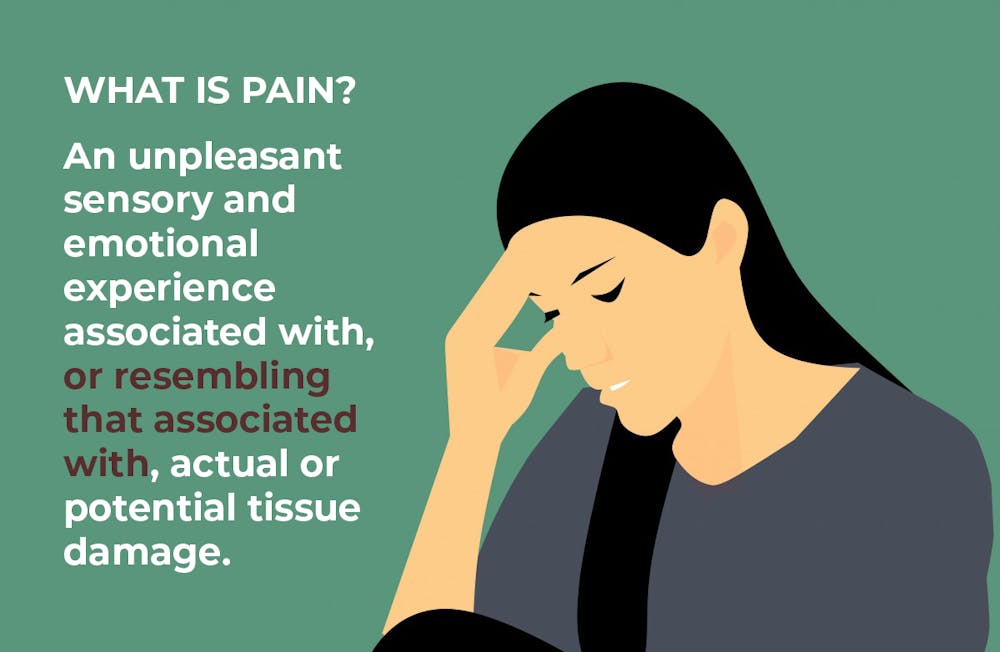We all know the feeling of pain. It may be as small as a scrape or cut or as extreme as a broken bone. But pain is not simply an unpleasant sensation or symptom caused by damage to our bodies. Rather, pain is a complex condition that we do not yet fully understand and that is not simply physical.
On the level of neuroscience, pain occurs when specific nerves called nociceptors detect tissue damage and transmit information about the damage along the spinal cord to the brain.
For example, touching a hot surface sends a message through a reflex arc in the spinal cord and causes an immediate contraction of the muscles. This contraction will pull the hand away from the hot surface, limiting further damage.
Despite improvements in our understanding, the definition of pain was not updated since 1979 — until now. This was the previous definition: “an unpleasant sensory and emotional experience associated with actual or potential tissue damage, or described in terms of such damage.”
Nearly 40 years after the 1979 definition, the International Association for the Study of Pain decided to rethink the working definition of pain.
They established a 14-member international task force with expertise in basic and clinical science related to pain. Together the team sought input from multiple stakeholders to determine how progress in pain research over the past few decades should inform the formal definition of pain.
Dr. Srinivasa Raja, professor of anesthesiology and critical care medicine at the School of Medicine, served as the chair of the task force.
Raja described the importance of the modified definition in an email to The News-Letter.
“Our understanding of pain allows improvements in patient care, science research and effective public health policies,” he wrote.
The results of the two-year study have now produced a new definition of pain: “an unpleasant sensory and emotional experience associated with, or resembling that associated with, actual or potential tissue damage.”
The definition now recognizes that pain may not result from “actual or potential tissue damage.” This change is mostly the result of increased understanding of many types of neurological pain which were poorly understood in the 1970s.
For instance, phantom limb pain was previously left out of the definition. Phantom limb pain is a type of neuropathic pain caused by a maladaptive nervous system and is commonly associated with limb amputations, chronic pains after surgery or nerve injuries. Another example is nociplastic pain, which occurs when pain receptors are stimulated without clear cause, such as with fibromyalgia.
Both these conditions can cause excruciating discomfort; however, it can be difficult for doctors to understand why the pain is occurring without any overtly physical change to the body.
Another major change in this definition is the removal of the word “described” from the new definition. Raja explained the importance of this omission of the word.
“The use [of] ‘described’ requires the patient to be vocal and able to communicate the pain,” he wrote. “Animals and some vulnerable individuals are not able to do that, so they were left out of the definition.”
One of the most important potential impacts of this new definition is an increased access to health care if insurance providers accept this new definition. For instance, this new definition recognizes all forms of chronic pain, which affects up to one-fifth of Americans.
The new definition, while an improvement, is not entirely perfect. Much of this has to do with the way we think of pain, as Raja explained in an email to The News-Letter.
“Pain is different for everyone, and there psychological, cognitive and social factors that contribute to the sensation and treatment of pain,” he wrote.
As scientists work toward new understandings of pain and its mechanisms, the scientific community hopes that the next update will come much sooner than 40 years from now.





